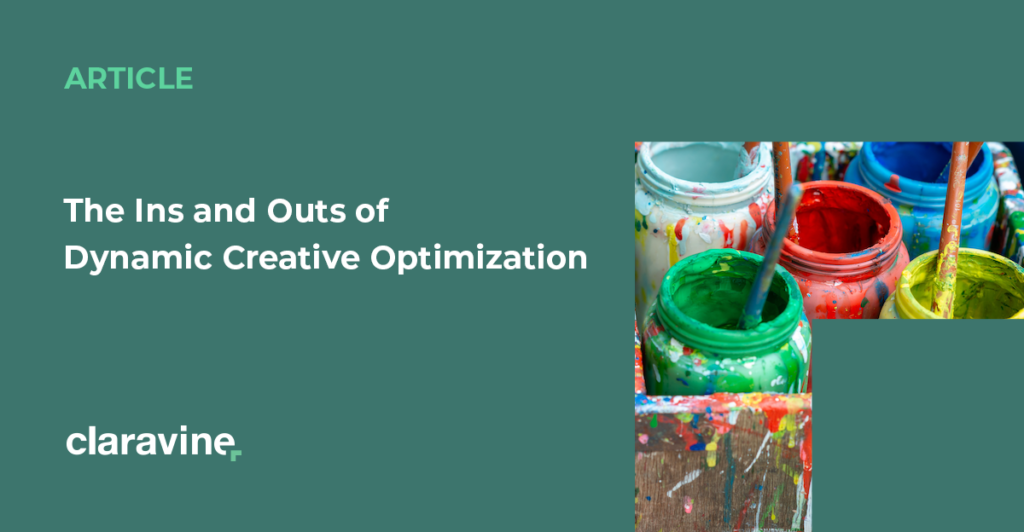The Ins and Outs of Dynamic Creative Optimization (DCO)

Successful brands market their products and services by telling stories that connect with their audiences on a personal level.
Of course, it’s tough to establish one-to-one connections through traditional marketing channels. Digital marketing — specifically, programmatic ads — has made it possible to provide individualized experiences. But, unfortunately, a lot of digital ads are irrelevant or downright spammy and fail to engage audiences and drive conversions.
Brands that utilize dynamic creative optimization (DCO) can create highly relevant, personalized ads on a large scale that resonate.
In this crash course, we’ll explore DCO, its benefits and applications, and some best practices for incorporating it into your digital ad strategy.
But to understand DCO, we need to take a step back and define dynamic creative first.
What is Dynamic Creative?
Dynamic creative is a method of programmatic advertising in which ad components — headlines, descriptions, images, CTAs, etc. — are changed in real-time according to parameters predefined by the advertiser. Common parameters include the time of day, weather, location, etc.
What is Dynamic Creative Optimization?
Dynamic creative optimization (DCO) is a supercharged form of dynamic creative that uses artificial intelligence (AI) and machine learning technology to create hyper-personalized experiences for viewers.
It’s an automated process that leverages existing customer data and other connected data sources plus real-time testing and analytics to select the most effective combination of creative elements for each viewer.
Levels of DCO
There are two levels within dynamic creative optimization.
Dynamic: Dynamic refers to pre-designed ad variants that have data-fed elements chosen and controlled by algorithms. They allow marketers to create highly personalized, rich, engaging creatives in real-time. Dynamic units are easy to set up and don’t require advanced technological know-how or coding experience.
Static: Static DCO uses static templates as the basis for providing a more personalized ad experience. Algorithms still determine which creative is shown to the viewer, but the number of ad variations is limited, and they take time and complex coding to set up.
Key Benefits of Dynamic Creative Optimization
There are many benefits of incorporating dynamic creative optimization as part of your digital marketing strategy. Here are the top four.
Personalization
We know there is a direct correlation between personalized ads and sales. One study indicates 80% of consumers are more likely to purchase if a brand provides a customized experience.
Your audience likely has specific needs and preferences. With DCO you can automatically deliver the right message for your Millennial audience and the 50-plus crowd in the most effective creative form.
Automation
Ad development used to be a manual, time-consuming, and expensive process — especially if you tried to curate ads for each of your audience segments.
Using dynamic creative optimization instead drives cost savings and increases the ROI on every marketing dollar. Once the technology is put in place and parameters are defined, DCO is a fully automated process. Marketers can add data sets, rules, and creative assets to the platform as needed and devote more time to other mission-critical tasks. But, of course, they’ll still need to monitor the performance of campaigns and make adjustments when necessary.
Real-time response
Creating ads the old-fashioned way takes a lot of time and resources. DCO allows you to address the needs of your audience starting the moment they visit your site. Tailoring creatives based on real-time data drives more engagement and conversions.
DCO also allows brands to shift their messaging according to changing global or regional conditions. Changing course in real-time can avoid potential reputational damage from showing tone-deaf ads during a sensitive time (i.e., during natural disasters, a local tragedy, etc.).
Improved performance and ROI
There’s no more waiting until after the campaign’s over to measure its performance and determine what to do better next time. Instead, DCO provides metrics and makes elemental adjustments to improve performance and conversions in real time.
And when ads are curated specifically for each user, conversion rates soar and increase the ROI of your ad spend.
So what does dynamic creative optimization actually look like?
How Does DCO Work?
When someone visits your site for the first time, you have no information about them. There’s no insight into their preferences, behaviors, or demographics. You’re limited to serving ads that are generic or representative of what typically brings visitors to your website.
But that’s not the case if you use dynamic creative optimization.
Even with first-time visitors, you learn a lot about them as they browse your site. For example, you may discover where they’re located. You’ll know which pages they’re viewing, where their mouse is hovering, and which products they placed in the shopping cart. You’ll also glean insight into their preferences, lifestyle, and demographics based on the products and specifications they gravitate towards.
Dynamic creative optimization leverages all of this information. And instead of serving a generic ad — or worse, something spammy — DCO designs creatives tailored to the visitor in real-time.
Of course, DCO is even more effective for returning visitors and existing customers, creating increasingly relevant ads that drive more engagement and boost conversions.
Inputs for Dynamic Creative Optimization
DCO ad servers rely on inputs from two primary sources to create targeted and personalized ads.
Data Management Platform (DMP)
A data management platform (DMP) is a software platform that collects, manages, and analyzes the data from every touchpoint you have with your customers and prospects.
These include digital touchpoints like interactions with your website, marketing campaigns, and social media. It also includes offline touchpoints found in your customer relationship management (CRM) system like call center inquiries, order history, personal information, contract renewal, and warranty information. Of course, it includes any third-party data too.
Your DMP feeds your DCO ad server with real-time data from these and any other connected data sources.
Examples of data management platforms include Lotame, Simpli.fi, and Oracle Data Cloud.
Creative Management Platform (CMP)
A creative management platform (CMP) is a cloud-based software for designing, managing, and distributing digital ad content. More brands are implementing CMPs to ensure each of their audience segments has a more personalized experience.
Essential components of a CMP include:
- An ad creator: Enables high-volume, effortless, intuitive ad creation and seamless integration of creative variants
- Real-time analytics: Provides metrics like click-through rate, bounce rate, views, conversions, etc., to highlight how to improve poorly performing ads
- Campaign management: Integrates directly with ad networks for a seamless publishing process
Once your DMP feeds your DCO server with real-time data, your CMP selects the appropriate graphical elements and copy to curate a personalized, relevant ad for the viewer.
Examples of creative management platform providers include Celtra, Ad-Lib, and Bannerflow.
Two-Part Optimization Process
Using dynamic creative optimization with your DMP and CMP allows you to generate those personalized creatives on the fly. There are two components to the optimization process.
- Content: The DCO platform determines the ad’s content to make it as relevant as possible for each viewer. It chooses which products to promote, the most effective value proposition and CTA, whether to use rich media or an image, etc.
- Design: The DCO platform leverages machine learning to determine the most appealing way to arrange the ad components for each viewer. It can optimize ad copy, color scheme, layout, and more to drive a conversion.
What Types of Ad Campaigns Can Leverage DCO?
Advertisers have historically used DCO to remarket previously viewed products to retail audiences. But DCO can enhance virtually any ad campaign. Suppose you already run ads programmatically, whether it’s through an agency or ad exchange. In that case, you probably have the ability to leverage DCO.
Here’s how you can leverage DCO in various ad campaigns.
- Demographic campaigns: Brands can leverage DCO to target users who share your customers’ characteristics such as age, gender, household income, interests, marital and parental status, and more.
- Product-based campaigns: DCO can create ads on the fly to target audiences who visited your site but may have abandoned their cart or upsell to those who did make a purchase.
- Local campaigns: DCO can use location, weather, language, or local flavor to create relevant ads for a specific geographic area. Advertisers can use geo-targeting to promote a nearby restaurant deal or a local weather report to advertise a winter outerwear sale or an outdoor experience.
- Contextual campaigns: Publishing random, irrelevant ads on web pages is guaranteed to annoy most audiences. DCO allows advertisers to publish ads that are dynamically tailored to the content on a web page — so they’re more likely to be relevant to the consumer.
- Customer journey campaigns: Brands can use DCO to create ads that mirror each stage of the buyer journey to encourage visitors along the path to eventual purchase.
- Behavioral campaigns: DCO can target audiences who have demonstrated interest in specific product categories and bring them into the sales funnel. DCO can engage those investigating products and solutions with a hyper-personalized message or an offer that will resonate.
Best Practices for Dynamic Creative Optimization
There are standard best practices for establishing an effective digital marketing strategy. Most apply to DCO too. Here’s what to keep in mind when implementing DCO so you can maximize engagement and drive sales.
- Know your buyer personas: It’s obvious but worth mentioning. You must know precisely who your customer is to market to them effectively. To inform your approach, you’ll need to complete a detailed buyer persona for each of your target segments. You can build (or enhance) yours with information from your CRM, customer service records, customer feedback, market data and trends, social media and communication preferences, to name a few.
- Go all-in on first-party data: With the deprecation of third-party cookies, it’s more important than ever to focus on collecting first-party data. DCO leverages the information you’ve gathered through interactions with your customers and visitors’ browsing behaviors to create a personalized experience for your target audience.
- Craft compelling copy: You probably have a content marketing strategy in place. The same rules apply to ad content — they just take on more urgency, given you only have a second or two to get viewers’ attention. So headlines, descriptions, images, and CTAs must be especially eye-catching and concise.
- Monitor performance: DCO is an automated process that uses machine learning instead of A/B testing to swap ad elements based on viewer response. But it’s still necessary to monitor which creatives propelled consumers on a path to purchase — and which ads did not.
- Stay on brand: With DCO, brands can combine creative elements to create a virtually limitless variety of ads for their audience segments. As always, you must ensure your messaging aligns with your brand voice and the trust and reputation you’ve established with your audience.
- Create a full-funnel strategy: Your DCO strategy should go beyond serving one-off, individualized creatives. Create a full-funnel strategy or a series in which each ad guides the viewer through every stage of the buyer journey to ultimate conversion.
Examples of Dynamic Creative Optimization by Industry
Here are some examples of ad versions specific verticals can create in real time for different audience segments using dynamic creative optimization.
- Automotive: Automakers and dealerships can use demographics and behavioral signals to inform which vehicle to promote to a viewer. A family-minded person who lives in the Rocky Mountain region might be served an ad highlighting the safety features of 4-wheel drive SUVs and crossovers along with a “dealer near you” that has top-rated models in stock.
- Financial services: A credit card provider can leverage audiences’ interests, spending habits, and income levels. A person with an average income who has demonstrated an interest in travel might be served an ad for a branded airline card with no annual fee.
- Education: A college or university can use demographics, interests, and preferences to target prospective students. A top engineering school could serve an ad highlighting merit scholarship opportunities to high school juniors who excel in math and science.
- Travel and tourism: Travel companies and airlines use data on properties viewed, preferred hotel chains, flight history, and more to personalize ads dynamically. A traveler that’s accumulated rewards might be served an ad for a favorite hotel in a destination they’ve previously researched.
- Ecommerce: The opportunities for DCO in ecommerce and retail are unlimited. Applications include creating time-sensitive ads for retargeting, such as flash sales and “offer of the day,” as well as special local promotions.
- Food and beverage: Food and beverage use geo-targeting and user preferences to serve relevant ads promoting regional menu items or location-specific specials and events.
Supercharge Your Digital Ads With DCO
Consumers have unlimited choices these days so it’s more important than ever to establish meaningful relationships with your prospects and customers.
Part of that is personalizing every interaction with your brand. Incorporating dynamic creative optimization into your digital marketing strategy will ensure you create highly relevant, meaningful ads for every person who visits your website.
Introducing DCO to your programmatic advertising strategy may require evaluating your business’ overall data management approach. Claravine can help establish relationships and patterns across your existing first-party data, creating data integrity and context that will be critical to realizing the full potential of dynamic creative optimization.
Contact Claravine to learn more.



